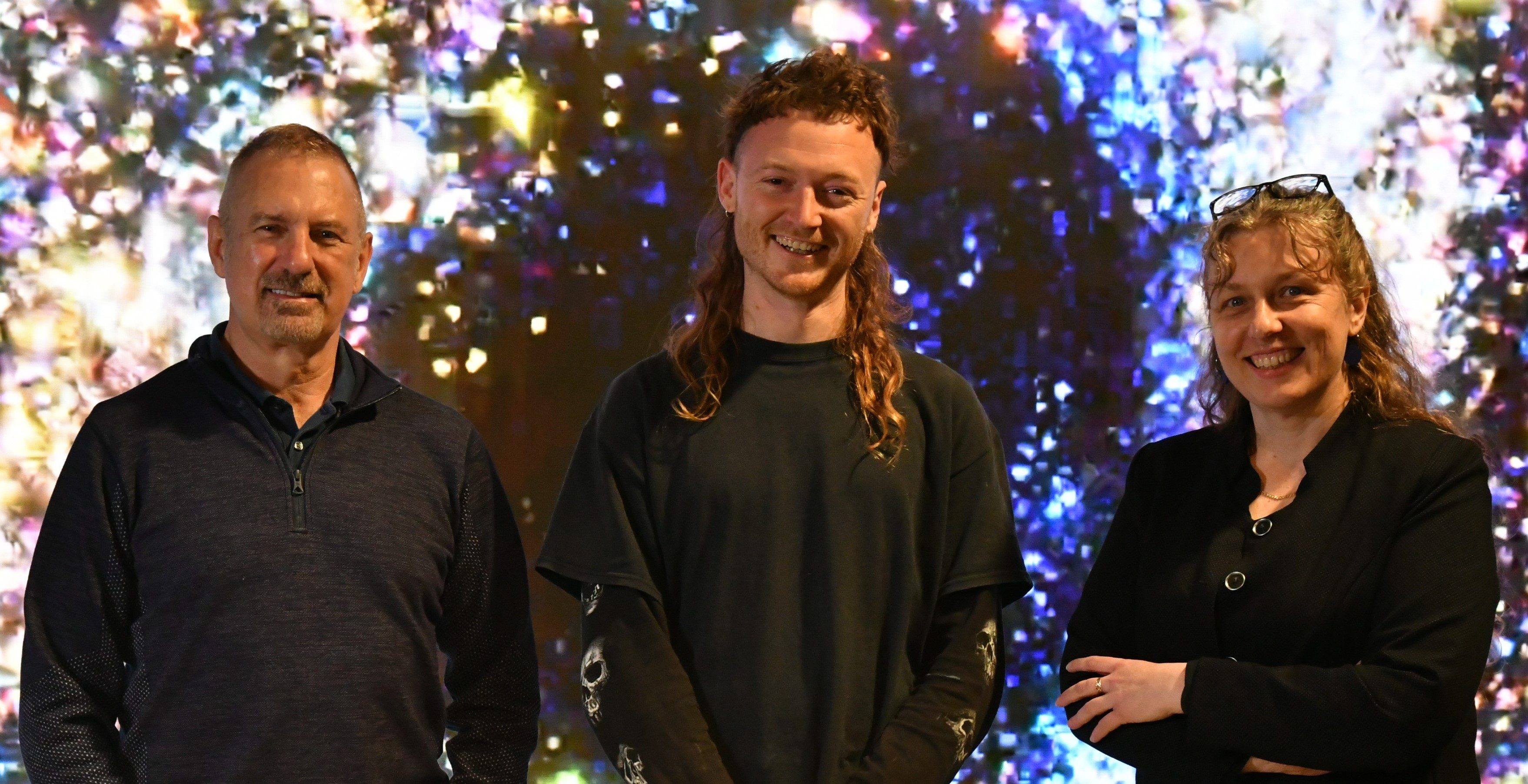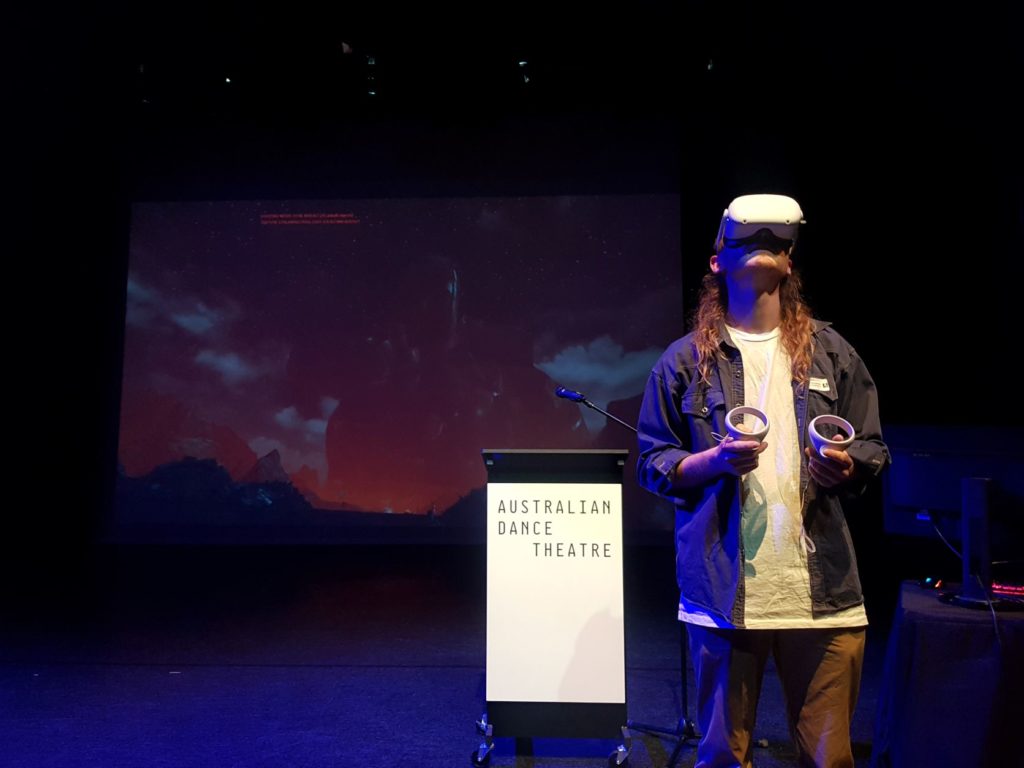
Each year Assemblage, Flinders’ Centre for Creative Arts, hosts an 8-week, fully funded Artist in Residence research program. This year cinematographer and video artist Liam Somerville was the lucky winner of the grant and able to experiment with Flinders Void’s cutting edge motion capture software to create his VR experience ‘Eschatech’.
Throughout his career, Liam has explored different technologies, both old and new. Most recently, he has delved into 3D and motion capture, focusing on the development of VR experiences. “I love adding new skills and experiences to my quiver of technologies. I really enjoy just experimenting and bending and stretching different techniques to find new visual outcomes” he tells us.
After working on a project in the Void in early 2021, Liam heard about the Artist in Residence program and got excited to potentially continue pushing Unreal Engine and the Vicon Motion Capture System to their limits and finding interesting ways to use the technology. “I was doing some work in the Void already and found it a really exciting place to be – at the coalface of technology. There was an enormous wealth of knowledge here on campus and so it was a logical step for me to keep experimenting in this space.”
Liam’s work aligns perfectly with the residency’s 2021 theme ‘Transformative and digital technologies’. “My work has often danced around the human interaction with digital space. I really like bringing human imperfections into a virtual space, which is often so clean and crisp. I like the human elements. There are certain aspects of that through motion capture by capturing human movement, but then also things like virtual cameras and getting that really kinetic control of a virtual interface”.
The concept for Liam’s project ‘Eschatech’
Under the working title ‘Anthropocene’, Liam created a simulation of the last 100 seconds of humanity for his Artist in Residence project. He later changed the title to ‘Eschatech’. “I felt Anthropocene was more the subject matter and not the actual title. So, I wanted to create a name that referenced the end of time but also had a futurist, posthuman feel to it. Eschatech is made up of Escha, coming from eschatology, which is the study of the end of the world, and tech.”
Inspired by the beauty and wonder of our natural environment in stark contrast to the destruction of this natural biodiversity caused by humans’ impact on the planet, Liam put together a somewhat bleak and semi pessimistic view of what the future could hold.
“Although I spend a lot of time on computers and surrounded by technology, I do have a really big passion for nature – conservation, revegetation, and all these kinds of things. I’m an avid scuba diver – I often dive with the Flinders University Underwater Club (FUUC) actually – and I like to enjoy the natural environment, the biodiversity of local plants and birds. The environment and climate change are something that I’m really passionate about. So, if there’s a way that I could transpose or share the importance of this biodiversity that’s getting lost through human decisions, that would be a great thing.”
With Eschatech, Liam is hoping to make an impact. “I hope my work will help people think about the real-world possibilities of where we’re headed as a humanity and how we are really on borrowed time. We really need to make big decisions and big changes now, if we want the planet to be the beautiful place that it is today, in maybe 50 years’ time.”
In the game, players wake up in an apocalyptic bunker and are greeted with the titans of human destruction. They have 100 seconds to explore the last pieces of our destructed planet before the end. In his last chapter, Liam used dystopian symbolism to showcase the environmental impacts of humankind: doomy hard techno playing in the background, no plants, no humans, nothing – what’s left is a dark world with rising sea levels. “In cinematography, you are often guided by light and sound, in my game I used carbon benefits and money to guide the player. In the end, these things don’t get you anywhere though, the game is still over.”

The perks of conducting research at a university
Liam had a strong vision of what he wanted to create but was also guided by different concepts and ideas that helped him refine said vision. “I had the content and look in my head all along. The research and conversations then helped guide those parts of the project and filled gaps or answered the guiding questions around the work. I always like including ‘creative spanners’ – unknowns that may change the outcome. In this case, they were questions around how the world will end or what that actually means?”
Working with professionals from all different aspects, whether that be post humanities, philosophy, the Drama Centre or the Assemblage team, Garry Stewart and Tully Barnett, sparked lots of ideas in Liam. “I came looking for answers and left with a thousand more questions. There’s an amazing fountain of thinkers here and so many interesting people that I’ve had wonderful conversations with. The personnel here have a great way to challenge and interrogate, to see things differently and troubleshoot their way through issues. There’s also lots of knowledge sharing and the door is always open for other people and creatives to come in. I really like that attitude.”
Another inspiration for Liam was the post humanities reading group with Stephen Muecke that he joined. “I hadn’t done much academic reading since I graduated from uni about 10 years ago, so this was a real deep dive back into academic reading, journals and critical thinking. Taking that big deep dive into posthumanism philosophy, was something that I hadn’t really done before and a real eyeopener.”
With the work Liam had already been doing at Flinders University, he’d been working with technicians, lecturers and students, who had all been vital in his creative process. “I’m so privileged to be in the building with so many great minds and thinkers. Honours student Bonnie Grant for instance has been awesome in driving the motion capture rig here and helping me with animation. Cameron Mackness and Jason Bevan have been wonderful, too. They are amazing at tackling technical issues and are extremely knowledgeable about Unreal Engine and motion capture and all these kinds of things. Dan Thorsland – he’s just got that endless enthusiasm! My plan was to mix and gel with the wealth of knowledge, students and everyone at Flinders to bring this project to fruition.” And he did.
Having 8 weeks solely dedicated to his Artist in Residence project helped Liam’s creative juices flow and gave him the chance to experiment with technologies such as photogrammetry – taking lots of photos and creating virtual, digital doubles or digital assets – and modelling inside of VR. “The Void really is special. I’ve had such an amazing time. It’s been great to create time and space and have the resources to work on something without having to jump between other projects. Devoting my time and focusing on just one project has been great.”

The time is now
With the digital media industry booming and South Australia strongly establishing itself as the hub within Australia, now is the perfect time to take up studies in Visual Effects and Entertainment Design. “I think it’s such an exciting time to be involved in these new technologies. It feels like every week there is some revolutionary piece of code or tech or a plugin or something that totally changes our whole workflow.
“It’s such an exciting time to be in this realm. Technology is moving so fast, the language around it is still being created and as humans, we are still evolving to work out how to use this technology, which I think is a really interesting paradigm. I feel that there’d be lots of opportunities for students studying here to get a really great first step into the industry and creative learning.”
Besides shooting a feature music documentary and further digital projects, Liam himself will continue working in the Void, extending the life of his project and creating different digital outputs from Eschatech. So watch this space! We can’t wait to see what he comes up with!

